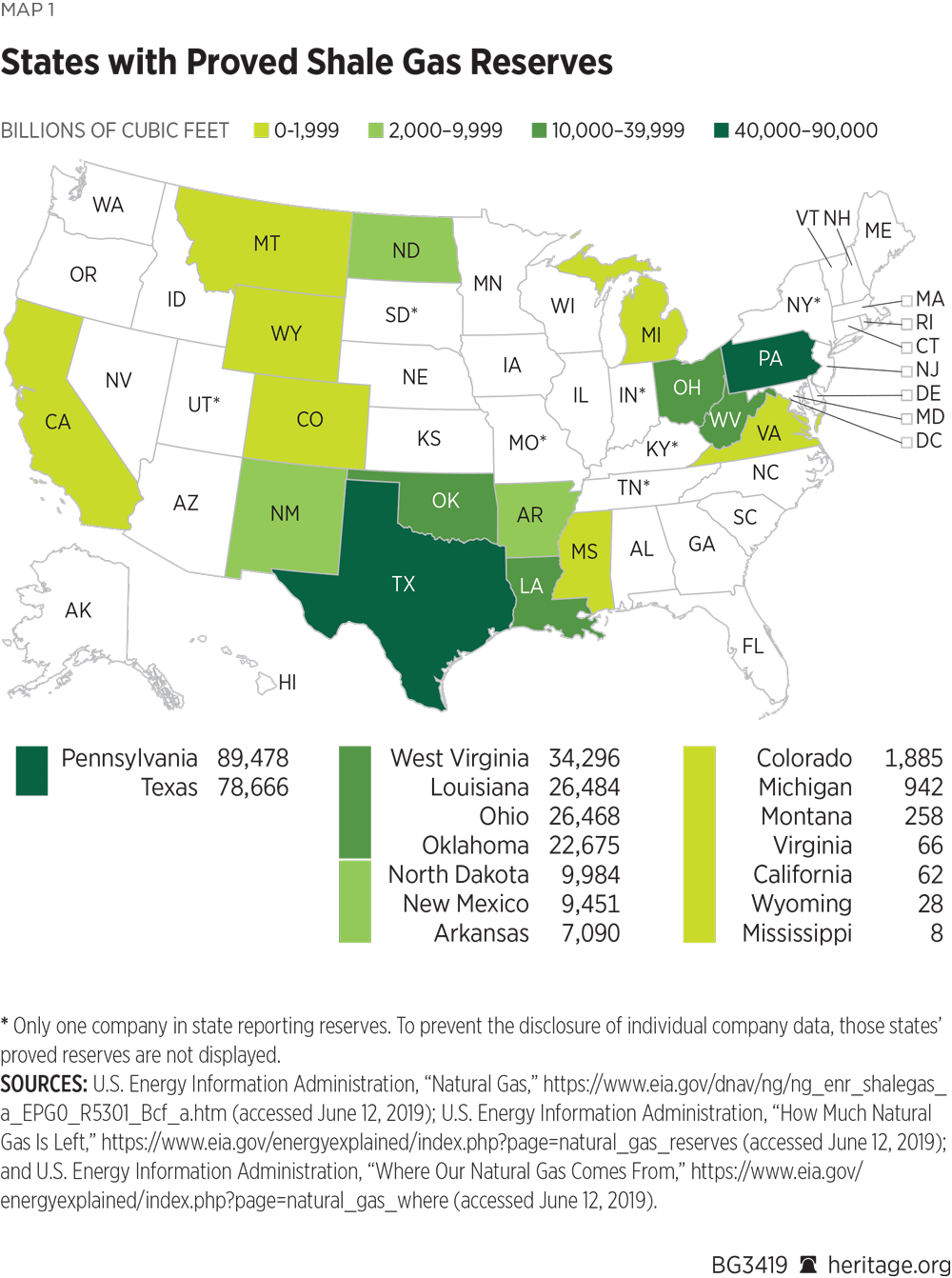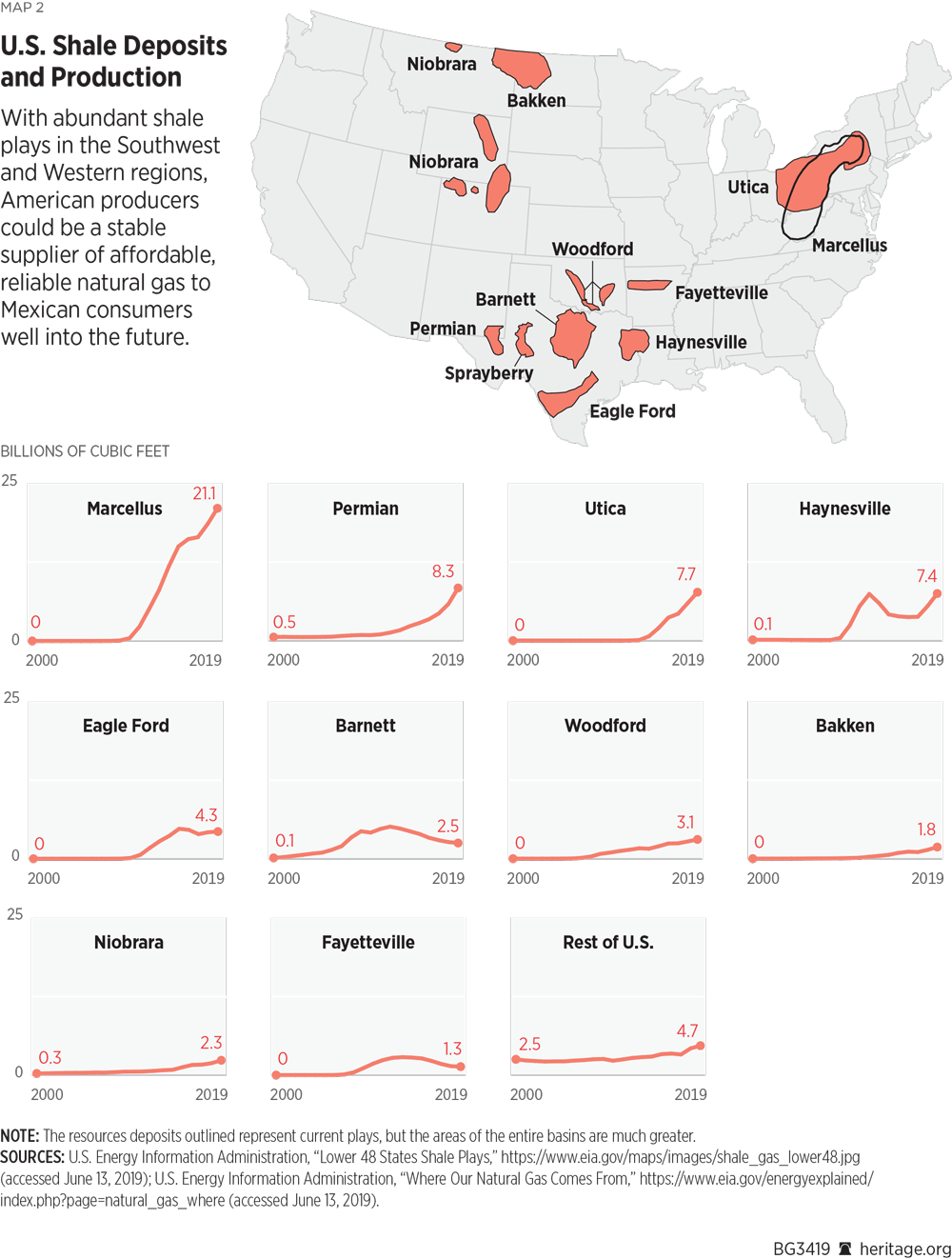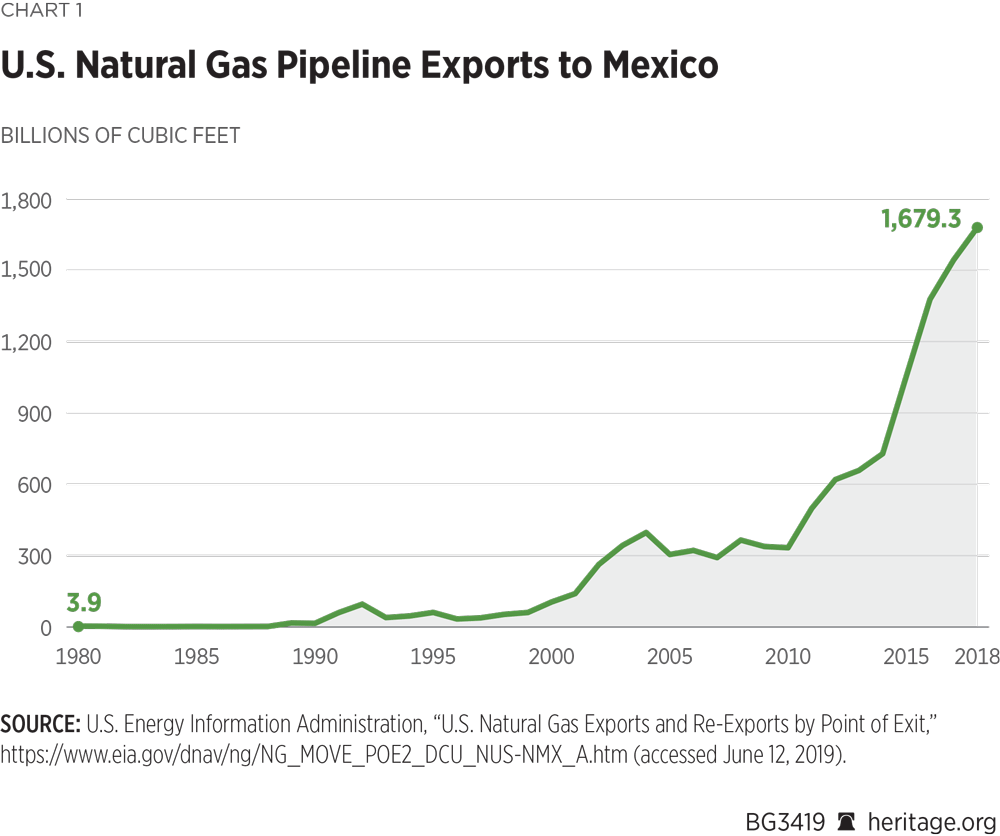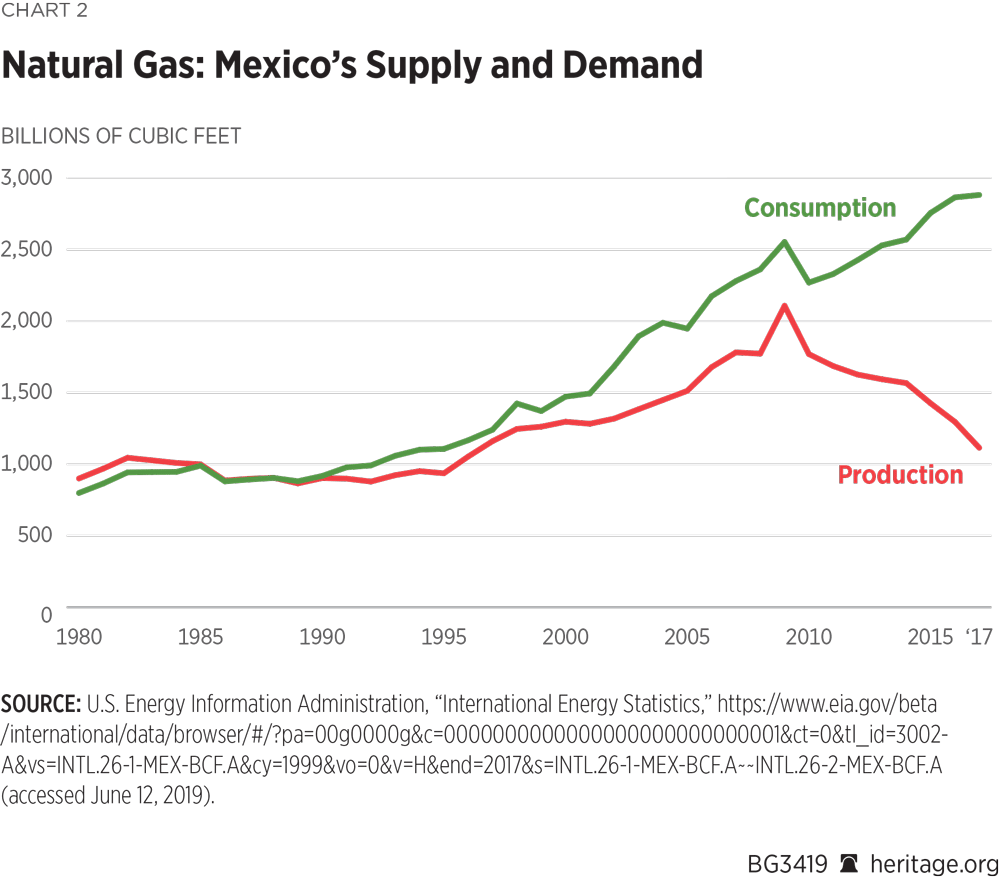Energy trade between producers in the United States and consumers in Mexico has long been a productive relationship, benefitting households and businesses on both sides of the border. Natural gas has become increasingly important for the Mexican economy as a necessary fuel source, particularly for electric power and industrial development. U.S. companies began exporting natural gas to Mexico via pipeline in 1988, and exports have increased significantly as the shale revolution in the U.S. produced affordable, abundant natural gas for consumers in the U.S., Mexico, and around the world.REF Liquefied natural gas (LNG)—which is transported by ship—supplements the pipeline trade in natural gas.REF Additional Mexican pipelines and LNG infrastructure will increase export opportunities for U.S. energy producers in the South and Southwest.REF
Concerns over the future of U.S.–Mexico energy trade are developing, however. Newly elected Mexican President Andrés Manuel López Obrador has been very critical of free-market energy reforms in Mexico and wants to return to more state control.REF President López Obrador is threatening to change pipeline contracts with the Mexican government and private American and Canadian companies, creating uncertainty in current and future investments.REF
The U.S. and Mexico should build on past policies that have enabled energy trade by expanding interconnectivity, honoring contracts and respecting the rule of law, and streamlining permitting processes for natural gas infrastructure. Americans and Mexicans will gain significant economic and security benefits as a result.
America’s Abundance of Natural Gas
Due to the shale revolution, the United States has been the world’s largest natural gas producer since 2009.REF Technological advancements in horizontal drilling and hydraulic fracturing have made America’s abundance of natural resources available for extraction and delivery. Domestic energy continues to be an enormous boon to the American economy, creating hundreds of thousands of direct jobs, and millions of jobs in supporting industries.REF Increased supplies have lowered energy bills for households across America. Abundant, low-cost power is also beneficial for energy-using businesses, especially America’s energy-intensive manufacturing base.
Both dry gas (without liquids) and wet gas (mainly associated with oil extraction and liquids) coming from the Permian Basin in West Texas and southeastern New Mexico are important sources of energy for Mexico.REF The Eagle Ford Basin in Texas is the primary source of cross-border pipeline gas export to Mexico thus far. Other sources of supply include the San Juan Basin located in northwest New Mexico, as well as natural gas resources spanning Colorado and Wyoming.
The success of energy production in the United States is largely a function of market risk and development by private companies. Market competition is spurring investments in new energy projects and the necessary infrastructure to transport it. Free markets, a strong rule of law and private ownership of resources, are the foundation for the energy renaissance in the U.S.
However, policy problems exist in the U.S., primarily with the government subsidizing the production and consumption of energy, in addition to all energy technologies having onerously long permitting processes for projects. Where government intervention is less invasive, energy markets thrive.


Expanded Opportunities in Mexico for U.S. Suppliers
Natural gas trade between American producers and Mexican consumers has increased substantially over the past decade. U.S. exports continue to break records as Mexico imported nearly 6 billion cubic feet of natural per day from U.S. suppliers last summer.REF One billion cubic feet of natural gas is enough to power 10,000 American homes for a year.REF
Most of Mexico’s energy imports travel through cross-border pipelines. Critical to the growth in trade was the expansion of pipeline capacity, both in the U.S. and across the border. Total cross-border pipeline capacity nearly tripled since 2011, from about 4 billion cubic feet per day to about 11 billion cubic feet per day.REF The expansion has not only increased the flow of energy but also expanded natural gas to different regions throughout Mexico.REF Additionally, Mexico is accessing the U.S.’s expanded LNG capacities in the U.S. Gulf of Mexico.REF While piped gas from the U.S. is displacing LNG imports from other countries, Mexico is increasing LNG imports from American facilities in the Gulf Coast.REF
Expanded natural gas trade is a win for both countries. U.S. producers have more opportunities resulting in market development, investment, job creation, and economic growth. Mexican consumers are receiving a stable, secure source of energy. Overall electricity demand has grown as the country’s economy has grown since 2005.REF Furthermore, Mexico’s industrial sector has grown 47 percent over the same period, increasing demand for natural gas particularly in the heavy metals and chemicals industries.REF Most of Mexico’s northern industrial region, including border facilities, depends on imports of natural gas for electric power, demonstrating how important U.S. producers are for Mexico’s economic development.

Overcoming Infrastructure Constraints in the U.S. and Mexico
Despite the growth in natural gas exports from the U.S. to Mexico, infrastructure bottlenecks in both countries constrain U.S. producers and Mexican consumers from maximizing energy trade. Permian crude oil and associated gas require additional pipeline capacity expansion to move it to markets. Transportation constraints block development of the full resource potential in the number of shale regions throughout the southwestern and western parts of the country.
This is a widely known takeaway capacity bottleneck. Takeaway capacity is the total capacity at which oil and natural gas move from a basin through pipelines. The pipeline bottleneck discounts the price of oil and natural gas in the region because the surplus supply that accumulates in the area forces producers to sell the product at a discount.REF Without the additional pipeline capacity, companies are also flaring gas (controlled burning) under rules of Texas and New Mexico regulatory authorities.
The area of West Texas is now undergoing a substantial build-out to bring more infrastructure capacity online this year and over the next few years.REF Developers are planning a five pipeline “wall of capacity” that will likely provide more than enough oil and natural gas capacity.REF Additional oil and natural gas resource production in the Greater Permian Basin should meet excess capacity. One project will transport two billion cubic feet per day in development that would serve as a Texas intrastate expansion to the Gulf Coast.REF Projects in development are expanding market supply for increased international consumption of LNG, including by Mexico.
Within Mexico, pipeline construction delays are inhibiting the ability to take advantage of the cross-border excess capacity. Some pipelines have become operational or are near operational. Bad weather and construction delays pushed back the use of the Valley Crossing Pipeline; however, the Federal Energy Regulatory Commission (FERC) recently gave permission to put the pipeline into service.REF The pipeline will have a capacity of 2.6 billion cubic feet per day and will be the largest natural gas pipeline that flows from the U.S. to Mexico.
Oil and gas companies have several incomplete pipeline projects in Mexico for other unforeseen complications as well. Canadian-based TransCanada stopped work on two natural gas pipelines in Mexico citing “social and legal” concerns.REF TransCanada argued that several Mexican municipalities made it much more difficult and expensive to obtain permits, and that “social groups have made irrational requests that border on extortion.”REF These groups include municipal groups demanding higher prices for permits, and community groups in locales where the company had properly consulted with the community, as required by law, where the groups are nevertheless unsatisfied with the agreement. Corruption and weak rule of law in Mexico threatens current and future energy-infrastructure investments and constrains economic opportunity.REF
Contrasting Pipeline Regulations in the U.S. and Mexico
With respect to U.S natural gas pipelines, projects begin in development stages by privately held companies. A company will begin with an assessment of the market need and typically enter into a pre-filing stage to engage with various government agencies and local communities. The lead federal regulatory body is FERC. FERC coordinates action with the Environmental Protection Agency, the Department of Transportation’s Pipeline and Hazardous Materials Safety Administration (PHMSA), bureaus in the Department of the Interior and the Army Corps of Engineers, as well as state and local governments.REF
In addition to conducting an environmental and safety assessment (conducted by the PHMSA), FERC also validates proposed projects based on demonstrated market need (evidenced by long-term contract commitments) and considers the potential of overdeveloping capacity. Under Section 7 of the Natural Gas Act, FERC regulates the construction and operation of interstate pipeline projections, ensuring that the projects comply with Department of Transportation safety standards.REF
The State Department participates with a Presidential Permit process in each case of a cross-border pipeline between the U.S. and either Mexico or Canada. After submitting requests for comment from different agencies, the Secretary of State makes a decision to approve or deny the project based on the national interest of the U.S.REF In order to increase or expand this permitted volume, or if a significant modification is made, a company must receive an amended presidential permit.REF
In contrast to the U.S. regulatory decisions focused on market needs, the Mexican government largely controls the economic and regulatory decisions for energy projects through central planning. Despite the liberalization of Mexico’s energy markets, there are still large elements of government control that differ from the U.S. market system based on private capital risk-taking. Mexico’s ministry of energy (SENER) ultimately controls the planning of infrastructure and the pipeline grid for electric power in connection to natural-gas-fired electricity. Under the energy reform legislation of 2014, CENAGAS, Mexico’s state-run natural gas operator, was involved in a five-year strategic planning process from 2013 to 2018.REF
Before the election of López Obrador in late 2018, the annual review of the five-year plan included incremental steps toward competitive natural gas markets. The goal of CENEGAS was to continue to diversify and open markets. CENAGAS conducted its first initial open season on its pipeline system with contracts similar to the U.S. “open season” commitments covering 97 percent of capacity and over 50 shippers.REF Nonetheless, CENAGAS remains an agency of the Mexican government and the multi-sector five-year-plan was not determined by free-market supply and demand competition but by state management.
Under continued free and open markets, Mexico’s pipelines would be open-access and regulated much like they are in the United States. Market reforms authorized the private sector to build, own, and operate Mexico’s natural gas pipelines, limiting Mexican government investment to existing infrastructure maintenance and modernization. However, with the election of President López Obrador, oil and gas policy in Mexico has changed from incremental market reform to resource nationalism.
Post-Election Concerns
The López Obrador government’s move to consolidate control over the country’s energy markets is jeopardizing present and future natural gas trade opportunities. President López Obrador’s opposition to current negotiated contracts, too much dependence on natural gas imports, and his preference for resource nationalism all have implications for the future of energy trade between the U.S. and Mexico.
With current natural gas contracts, most of the capacity is under a take-or-pay provision at a fixed or predetermined rate over a 25-year period. Under take-or-pay, private pipeline operators charged the federal electricity commission (CFE) for natural gas volumes whether Mexico takes the gas or not. Since Mexico pipeline capacity is not yet in place to take the gas, the Mexican government must pay either way. Private pipeline companies have force majeure clauses, which relieve a company from fulfilling its contractual obligation because of circumstances beyond their control. In this instance, a company’s force majeure clause stipulates that the CFE must pay pipeline developers even though the pipelines are not yet in operation because of protests, legal challenges, and attempts at extortion.REF
Companies, such as TransCanada, have stated their desire to work with the CFE and the rest of the Mexican government to resolve the delays in construction.REF American pipeline companies support fixed-capacity take-or-pay systems as a requirement for financial lenders and investors to approve large pipelines for higher volumes. However, President López Obrador opposes the existing natural gas pipeline build-out contracts between the CFE and American pipeline companies.REF Mexico is investigating the contractual process for uncovering any potential illegal activity by Mexican negotiators. President López Obrador said that the CFE will renegotiate its fixed-capacity take-or-pay contracts.REF Mexico’s energy regulatory commission (CRE) is denying accusations of any wrongdoing.REF
Another risk to natural gas trade between U.S. producers and Mexico’s consumers is the potential of increased import-substitution policy from the new Mexican government. Import substitution proposes that Mexico reduce or replace imports with its own domestic natural gas production. Imports of natural gas from the U.S. make up nearly 60 percent of Mexico’s total consumption.REF Under current supply and demand estimates, the percentage of natural gas imports could reach 70 percent.REF
How much more dependence will be politically acceptable for the Mexican government? The expected revision of the 2013–2018 plan will reflect the objectives of López Obrador. The reality of increasing amounts of natural gas flowing from the U.S. will stimulate an important substitution-policy debate by Mexico’s new government about how to increase supplies domestically. With López Obrador’s desire to return to elements of resource nationalism, one way to accomplish higher domestic production would be through increased production by state-owned companies and increased central planning. In fact, CFEnergia—the fuel-marketing affiliate of CFE—recently stated that it will prioritize natural gas supplies for PEMEX and other state-owned entities to lower energy costs and increase output.REF
Even so, there will be challenges for Mexico’s government and PEMEX, the state-owned petroleum company, if they choose to substitute U.S. imports with domestic production. Mexico’s natural gas production decline is expected to rebound only slightly until 2025, and then rapidly with technology advances.REF New production would require a six-year build-out and necessitate the hydraulic fracturing and horizontal drilling in large parts of Mexico. Domestic production will need social and political consensus to move forward.

Energy Trade in the United States–Mexico–Canada Agreement (USMCA) and the Trump Administration’s Tariff Announcements
An important component to the flow of U.S.-produced natural gas to Mexico is the new North American Free Trade Agreement (NAFTA). Productively, the USMCA maintains the NAFTA provision that there will be no tariffs on raw and refined oil and gas products. Maintaining no tariffs will keep important energy trade relationships intact and benefit North American energy consumers.
U.S. oil and gas companies and power providers will keep their eligibility to use investor-state dispute settlement (ISDS) for energy investments in Mexico. ISDS is an international arbitration process that protects investors, for instance, if a foreign government seizes an energy company’s property. Locking in the legal framework of ISDS protection and keeping Mexican hydrocarbons open to foreign investment will strengthen American companies’ commitment to remaining in Mexico.
In another provision specific to Mexico, the USMCA asserts that the Mexican government has
direct, inalienable and imprescriptible ownership of all hydrocarbons in the subsoil of the national territory, including the continental shelf and the exclusive economic zone located outside the territorial sea and adjacent thereto, in strata or deposits, regardless of their physical conditions pursuant to Mexico’s Constitution.REF
Though the provision is not surprising, Mexico’s stated federal ownership of its natural resources is a missed opportunity to capitalize on a critical feature of the American energy renaissance: private property rights. The United States is the world’s largest oil and gas producer not solely because of its abundant reserves. Much of the growth in production is occurring on private and state-owned lands where permitting time frames are sensible, therefore encouraging private investment.
However, Mexico’s market reform did open energy exploration and operation to foreign companies, and the new trade agreement includes a commitment that Mexico retain at least its current level of openness.
More recently, the Trump Administration announced a 5 percent tariff on all goods imported from Mexico, until later backing off after reaching an agreement with the Mexican government. The tariffs would have been implemented as a response to illegal immigration from Mexico, increasing 5 percent each month until they reached 25 percent in October. The Mexican government agreed to increase security at its own southern border, causing President Trump to withdraw the scheduled tariffs; however, the President also warned that future tariffs could still be an option.REF
Tariffs will not only harm American consumers but they will also harm President Trump’s “energy dominance” agenda. The decision could jeopardize current and future energy projects and the advancement of the USMCA. Furthermore, U.S. refiners will incur higher prices when importing Mexican crude oil. The result will be higher energy prices for both American and Mexican families and businesses. Even the threat of future tariffs creates uncertainty and uneasy relationships among stable trading relationships.
Recommendations for Mexico and the United States
Energy investments for production, sale, and consumption should be market-based, not held hostage to procedural red tape, subjective determinations, or political biases. Both governments should recognize the importance of U.S.–Mexico natural gas trade as a strategic benefit to avoid the high economic costs and dysfunction that results from resource nationalism and state control. Mexico’s should welcome the economic and geopolitical benefits of natural gas deliveries from the United States. To improve natural gas trade between U.S. energy companies and consumers and Mexico, a number of reforms and commitments should take place to reduce barriers and improve market conditions. Specifically, Mexico should:
- Commit to its market reforms and deregulated energy markets. SENER should permit projects based on market need rather than centrally planning Mexico’s energy markets. Doing so would likely encourage economically efficient fuel switching. For instance, Mexico still uses oil for electricity production where it would likely be more economically and environmentally beneficial to switch to natural gas.
- Honor contracts with privately owned pipeline companies and resolve state and local issues that are causing unnecessary construction delays. Honoring the contracts will be critical to ensuring legal and financial certainty for current and future investment in Mexico. U.S. exporters and pipeline infrastructure managers require improved transparency for competitive financial market efficiency.
- Examine the Gulf Coast over-concentration of natural gas supply. Tumultuous weather in the Gulf Coast can threaten natural gas exports to Mexico. One way to reduce that risk is through diversification. Mexico has recognized that natural gas imports from Texas, New Mexico, and the Rocky Mountain energy corridor have both economic and strategic advantages. The Mexican government should continue to recognize the benefits of supply diversification.
The United States should:
- Ensure the timely environmental review and permitting process for pipeline projects. Congress should repeal or reform major environmental statutes, such as the National Environmental Policy Act and the Endangered Species Act, and ensure that activists do not tie up projects for years of costly and unnecessary litigation.
- Reform presidential permitting process that determines whether projects are in the U.S. national interest. Federal bureaucrats and special interest groups have turned national and public interest determinations into pretexts to obstruct energy infrastructure and bring forward seemingly endless lawsuits. In the case of the Keystone XL Pipeline from Canada to Mexico, the State Department concluded that the pipeline was environmentally safe and would provide a steady oil supply from a friendly, secure, and reliable trading partner in Canada; however, the Obama Administration used a national interest determination to reject the pipeline permit.REF Congress should reform environmental and judicial reviews that threaten Mexico’s ability to purchase natural gas from U.S. producers.
- Withdraw any tariffs on Mexican imports. Punitive tariffs are not the correct solution for a broken immigration system. They only serve to harm American businesses and households. The Trump Administration should withdraw the enforcement of tariffs on Mexican imports.
Conclusion
Increased energy trade has important economic and strategic significance for the United States and Mexico. Mexico’s energy-market reforms that opened access and improved natural gas trade between American producers and Mexican consumers have been beneficial for citizens in both countries. President López Obrador’s desire to return to energy nationalism threatens those gains. Both the U.S. and Mexico should commit to policies and regulations that continue to open access to markets, improve transparency, and expand opportunities for investment. Doing so will benefit both Americans and Mexicans.
Daniel Fine, PhD, conducts research at the New Mexico Institute of Mining and Technology (New Mexico Tech). Nicolas D. Loris is Deputy Director of, and Herbert and Joyce Morgan Research Fellow in, the Thomas A. Roe Institute for Economic Policy Studies, of the Institute for Economic Freedom, at The Heritage Foundation.



